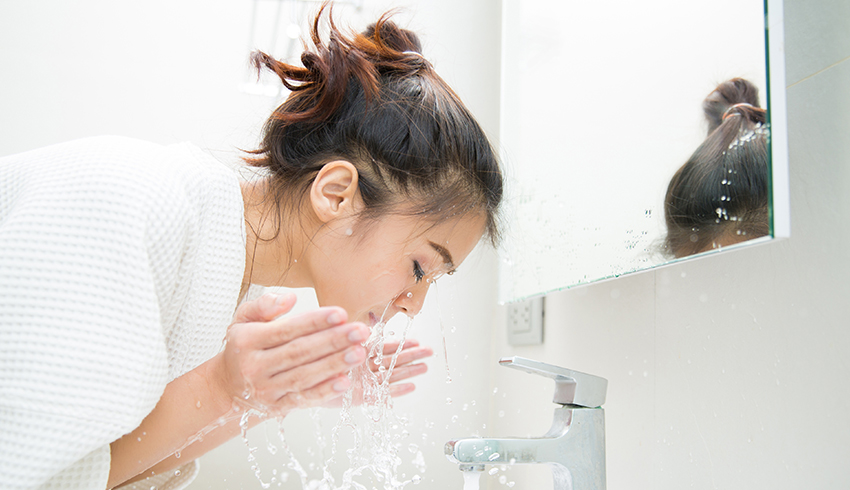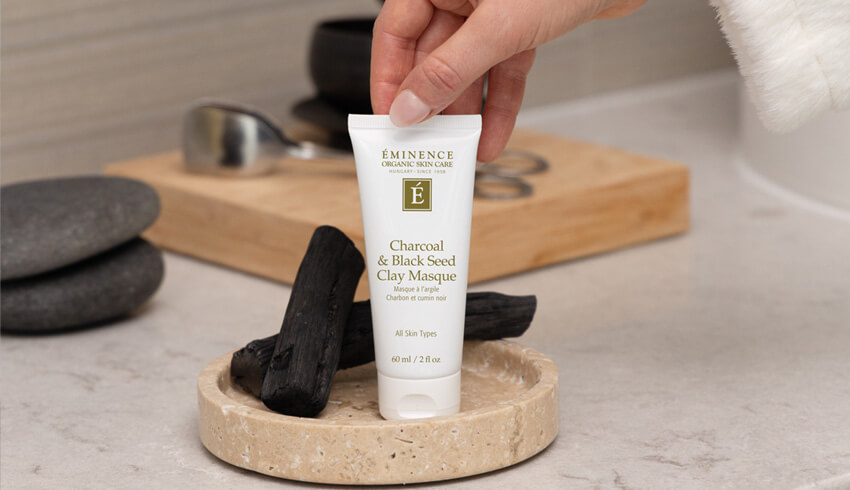
Acne as a teenager is a given. We know the drill: Puberty hits, our hormones go into overdrive, the breakouts last a few years, then acne moves on … right? Wrong. For many women, acne occurs for the first time past their teenage years and often well into adulthood. The culprit: hormones. Here’s everything you need to know about hormonal acne as well as our tips for keeping hormonal skin clear and blemish-free.
Causes of Hormonal Acne
Hormonal acne refers to cystic breakouts that emerge in adulthood due to hormonal fluctuations. In women, progesterone, estrogen and androgen levels vary during monthly cycles as well as life events like pregnancy and menopause. Variance in the ratio of androgens to progesterone and estrogen can cause a disruption in the skin’s normal functioning, setting off events that lead to the development of hormonal breakouts.
When androgen levels increase, receptors in the skin trigger an increase in sebum production and cause the pore lining to thicken. This contributes to oil build-up, bacteria growth and breakouts. Eminence Organics President Boldijarre Koronczay says: “When there is an increase of testosterone and decrease in estrogen, the skin responds by producing more oil. This overproduction of oil creates congestion which then creates acne-causing bacteria.” This not only contributes to the emergence of new breakouts but can also aggravate any existing acne symptoms.
Signs Your Acne Is Tied to Your Hormones
Not sure if your acne is hormonal? Here are three key indicators to help you identify if hormones are the source of your breakouts.
Timing Of Breakouts
Hormonal acne typically emerges in adulthood and can be triggered by a woman’s menstrual cycle, pregnancy and/or menopause. Dr. Lily Talakoub of McLean Dermatology and Skincare Center tells us that acne after the age of twenty-five tends to be hormonal. In fact, more than fifty percent of women in their twenties struggle with acne that is linked to their hormones.
Menstruation
For many women, hormonal acne emerges or worsens with the hormonal highs and lows of their cycle. Dr. Anjali Mahto tells Refinery29: "About two-thirds of acne-prone women will note worsening of their acne typically occurring anywhere from a week to a few days before the start of their period. This is because female hormones are at their lowest, and male hormones (androgens) are higher at these points."
Pregnancy
Hormonal acne can also occur before, during and after pregnancy. S. Manjula Jegasothy, MD tells SELF: “Your 20s is often peak childbearing age, making women more prone to the intense hormonal fluctuations of pregnancy, childbirth and lactation (breastfeeding).”
Many women experience postpartum acne due to the significant drop in estrogen and spike in testosterone immediately after delivery. For some, it can take up to a year for hormones to normalize and breakouts to subside.
Menopause
It is common for women to experience menopausal acne as well. As menopause approaches, estrogen levels drop but androgen levels remain constant. The resulting estrogen-androgen imbalance causes the effects of testosterone to amplify and acne to rear its angry head. Menopausal acne is exacerbated by the low rate of regeneration typical of older skin, which contributes to the build-up that causes breakouts.
Location
A telltale sign of hormonal acne is where it pops up. Dr. Lily Talakoub tells us hormonal acne typically presents on the lower third of the face, along the chin, jaw and neck. The reason: Oil glands that are stimulated by androgen spikes tend to be concentrated in this area. Marina Peredo, MD tells SELF: “These excess oil glands make your skin a prime spot for these types of breakouts.” This is compounded by our tendency to touch these areas throughout the day, transferring dirt and germs from our hands and cellphones to our faces.
Types Of Acne
Another clue that your acne is linked to your hormones is the appearance and feel of your breakouts. Hormonal acne can appear as blackheads and whiteheads, but most prominently manifests as deep and painful cysts. These have no visible head but are red, inflamed and tender to the touch. According to Mindbodygreen: “You may feel a sensation of pain or pressure where you have a pimple even when you’re not touching it, or it might feel painful with even gentle pressure as you wash your face.”
How To Fight Hormonal Breakouts
Two ways to tackle hormonal breakouts are with your diet (internal) and your skin care (external).
Diet: EAT Inflammation-Fighting Foods
One way of curbing the effects of hormonal acne is through your diet. As well as limiting foods that increase inflammation (like sugar, dairy and refined carbohydrates), you can add foods to your diet that promote hormonal health.
Helpful foods to combat excess androgens include:
- Healthy fats (coconut oil, avocado and egg yolk)
- Licorice and mint
- Leafy greens (spinach, broccoli and kale)
- Foods high in zinc (chicken, shellfish, sunflower and pumpkin seeds)
- Omega-3 fatty acids (plant oils, fish, nuts and seeds)
Skin Care: Acne Advanced + Eight Greens
You can also tackle hormonal breakouts with your skin care routine. Our Eminence Organics Product Support Team Leads recommend pairing the new Acne Advanced 3-Step Treatment System with the Eight Greens Collection to tackle the appearance of hormonal problem skin.
A key ingredient in the Acne Advanced Treatment System is encapsulated salicylic acid, a BHA that exfoliates skin, deep cleans pores and kills acne-causing bacteria. When used together, the products in the Acne Advanced 3-Step Treatment System treat and prevent moderate to severe breakouts, without irritation. Watch Vanessa’s story to learn how this new collection helped clear her postpartum acne:
Another beneficial ingredient for hormonal skin is phytoestrogens. Boldijarre tells Cosmopolitan: “One safe way to topically treat hormonal acne is to incorporate products with phytoestrogens into your skin care regimen… Phytoestrogens bring balance back to the skin, regulating oil production and eliminating bacteria.” Our Product Support Team lead recommends adding Eminence Organics Eight Greens Phyto Masque - Hot to your acne skin care routine. The whole plants and seeds in this stimulating face mask are naturally high in phytoestrogens that help improve the look of problem skin.
Professional Help: Visit an Esthetician or Dermatologist
When in doubt, always seek the advice of a professional. If you are battling hormonal acne, we highly recommend visiting a dermatologist or booking an appointment at an Eminence Organics Spa Partner. In addition to the steps listed above, having your skin properly assessed by a dermatologist or licensed esthetician is a smart step towards finding a long-term solution to your skin concerns. You can also watch our Lead Skin Skin Care Trainer Natalie Pergar as she discusses the causes of hormonal acne.
Do you or does someone you know struggle with hormonal acne? Share your #AcneAdvancedStories with us in the comments below and join the conversation on social media.


